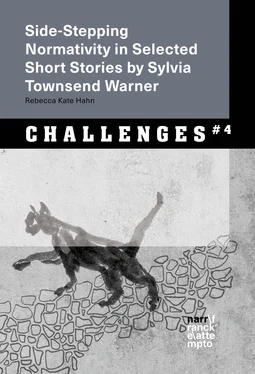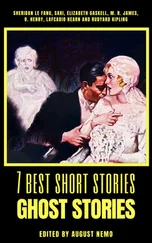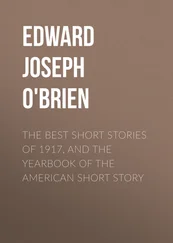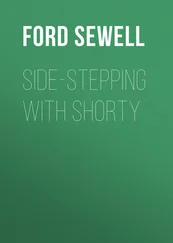Warner’s estrangement from the dominant ideology is crystallized in these narratives’ matter-of-fact crossings of borders that are generally assumed to be impassable: the incest taboo [“A Love Match”], the line between the human species and others animals [ The Cat’s Cradle Book ], the distinction between the material and the supernatural [ Kingdoms of Elfin ]. What all this crosswriting of borders does is to blur rather than to cross the lines between genders, sexualities and species: not just hierarchies but boundaries themselves are made ridiculous. ( Lesbian Empire 45)
Wachman suggests that the literary works in question do not necessarily seek to reverse or deconstruct (hetero-) normative value systems and/or boundaries. Rather than contesting them, Warner’s stories subtly expose their absurdity.
The reviews as well as the literary criticism, including Wachman’s assessment, all revolve around Warner’s lack of desire to conform to any standard or norm; either in terms of style, or content. They all confirm Maxwell’s humorous remark about Warner’s oeuvre – that her novels must be a “work of a secret society” and that an “affiliated sub-secret society” must have written the short stories.
The Queer Lolly Willowes Way: Drifting Away from Normativity
To Eve Kosofsky Sedgwick, “paranoid readings” are driven by the desire to expose “truths”, dominant ideologies and hegemonic structures in texts and other cultural phenomena. She writes, “[…] paranoia is characterized by placing, in practice, an extraordinary stress on the efficacy of knowledge per se – knowledge in the form of exposure” (Sedgwick, Touching Feeling 138). In her essay “Paranoid Reading and Reparative Reading, or, You’re So Paranoid, You Probably Think This Essay is About You” (1997, revised and reprinted in Touching Feeling 2003), an essay “[…] in which she diagnoses current research in the humanities with a pathological need to find ‘meaning’ in everything, and make knowledge explicit”, Sedgwick discusses “paranoid readings” and considers “reparative” ways of engaging with texts (Bauer 40). In this context, she highlights the parallels between paranoid readings and what Ricoeur terms the “hermeneutics of suspicion”, an approach favoured by Marx, Nietzsche and Freud which is marked by a strong distrust of given structures. Sedgwick suggests that little benefit can be gained by repeatedly querying how a text and other cultural, political, and historical phenomena address, for example, hidden homoerotic desires, criticise capitalism, or question other norm-enforcing structures. She maintains that it is much more beneficial to concentrate on the intricacies of a text and allow for surprises than to paranoically search for systemic oppression. The authors of the special issue of Differences: A Journal of Feminist Cultural Studies , entitled Queer Theory without Antinormativity (May 2015), discuss similar questions. Like Sedgwick, the authors – prominent queer theorists such as Annemarie Jagose, Robyn Wiegman and Heather Love – address the question how readers can approach texts from a non-antagonistic position. They do not distinguish between “paranoid” and “reparative” readings, but between oppositional and non-oppositional ways of addressing a text or an event. This discourse on non-dualistic thought, analysis and action reveals a strong desire to abandon former ways of thinking. My hypothesis is that, on a narratological level, Warner’s short stories do exactly what Sedgwick and the authors of Queer Theory without Antinormativity set out to show on an analytical level.
Nonnormative, that is, deviant, marginalised, non-heterosexual behaviours, desires and structures have traditionally been a topic of exploration for queer studies. In an attempt to sum up the objectives of queer studies, Donald E. Hall and Annamarie Jagose state,
Queer studies’ commitment to non-normativity and anti-identitarianism, coupled with its refusal to define its proper field of operation in relation to any fixed content, means that, while prominently organized around sexuality, it is potentially attentive to any socially consequential differences that contribute to regimes of sexual normalization. (xvi)
Hall and Jagose emphasise that queer studies seek to question and debunk modes of normalisation, particularly those related to sexuality, and choose to identify normalisation and normativity as the starting point for most of the research conducted in queer studies. In the special issue of Differences , Jagose, Wiegman and Love et al. discuss the possibility of queer theory without antinormativity and question why queer studies are so automatically linked to antinormativity. In their introduction, the editors Wiegman and Elizabeth A. Wilson ask “[C]an queer theorizing proceed without a primary commitment to antinormativity?” (1). They question whether it is possible to do queer studies without a constant focus on normativity (i.e. the rules and regulations that determine the so-called norm), normalisation, and, in addition to Hall and Jagose’s list, normalcy (the state of being “normal”). Wiegman and Wilson do not claim that queer studies should ignore focusing on norms and regulations, rather they seek to explore whether it is possible to do queer research without encountering norms and regulations on oppositional terms (“anti-normativity”). Wiegman and Wilson argue that by insisting on the belief that antinormative criticism is the only way to dismantle norms and normativity, queer theory creates a duality that it, in effect, is attempting to eliminate.
The introduction of Queer Theory without Antinormativity in particular, but also the journal in general, has met with harsh criticism. Jack Halberstam, for example, maintains that the editors create their own, simplified version of queer theory, which is mainly characterised by its opposition to existing norms (see “Straight Eye”).6 On this point, I would agree with Halberstam who contests the fact that all queer theorists follow a notion of antinormativity characterised by a simple stance against normativity – see, for example, Sedgwick’s work on non-dualistic thought in the introduction to Touching Feeling . Rather than insisting on antinormativity, which entails being against any form of normativity, I would argue that queer critique creates spaces in which normativity is tested, debated and toyed with – spaces in which nonnormative modes, in all their diversity, can be explored.
My understanding of the term “queer” builds on Halberstam’s and Lisa Duggan’s definition of “queer”. Halberstam does not employ the term “queer” to merely refer to sexual identities but to a way of life that defies the norm, to “eccentric modes of being” ( Queer Time and Place 1). Halberstam states, “If we try to think about queerness as an outcome of strange temporalities, imaginative life schedules, and eccentric economic practices, we detach queerness from sexual identity […]” (1). To me, the temporal and the uneconomical aspect of Halberstam’s definition is particularly important. In his writing, Halberstam does not exclude sexual orientation, but refrains from making it the focal point of his work. Duggan breaks the term “queer” down into three different categories – which, as she maintains, can exist simultaneously.
(1) Identity, or queer as a synonym for LGBT populations; (2) Practice, or queer as a broad umbrella term for dissenting sexual practices and gender expressions, and (3) Politics, or queer as a designation similar to feminist that appears quite independently of an advocate’s identity or sexual/gender practices. (Duggan)
Duggan describes how the term “queer” can be applied to different contexts – identity, practice, and politics. I find Duggan’s approach useful since she, in contrast to Halberstam, explicitly refers to queer as a “broad umbrella term for dissenting sexual practices and gender expressions”. This aspect of queer is particularly relevant for the first three chapters which revolve around nonnormative sexual desire. Accordingly, the term “queer” will henceforward be used to refer to nonnormative temporalities and desires.
Читать дальше












